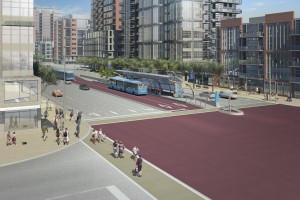A BRT isn’t just any old bus system. It’s a highly complex system that quickly transports thousands of people reliably every day. The best systems, cough…vivaNext…cough have dedicated bus only lanes to avoid traffic congestion and maintain a fast level of service. While no transit system is perfect, BRTs are some of the most effective systems around. They’re lower cost than rail, have a high capacity, offer riders speed and reliability and have the flexibility to be redirected where needed.

You may not know this but York Region is one of only a dozen communities in Canada that has what is called “Bus Rapid Transit”, fondly referred to as BRT in the transit industry. In fact, York Region’s BRT stands shoulder to shoulder with communities like Calgary, Montreal, Halifax and Vancouver.
When we were laying the groundwork for vivaNext, we naturally took a good look at the BRTs throughout Canada. One of the most extensive transit systems in the country is located in our nation’s capital. While Ottawa has been getting plenty of bad press due to a recently resolved transit strike, Ottawa’s bus system is truly a marvel. Ottawa faces challenges related to urban sprawl – to compensate the city has built a 30 km dedicated bus-only lane that winds its way throughout the city and adjacent communities.
According to an analysis done by the Canadian Urban Transit Association, Ottawa’s BRT system can carry up to 10,000 passengers and 185 buses per hour in each direction.
Vancouver is also doing some truly remarkable work. Vancouver’s BRT system was first introduced in 1996 in advance of a planned rail transit system. In response to the population growth, the Province of British Coloumbia announced they will invest $1.2 billion in 9 Rapidbus BC routes by 2020.
What is clear when you look at both cities is that BRT is an essential part of any transit system. Municipal bus service, BRT, LRT, subway and trains – they all play an important role in an overall transit network to supply adequate, cost-effective service that’s fast and convenient.
What great cities have you visited that had wonderful transit systems?

One reply on “Why a BRT is not a bacon, relish and tomato sandwich”
BRT is an essential part of public transit, along with municipal bus routes, LRT, subway, commuter rail, and DMU rail (think of Ottawa’s O-Train). All have their place in the big picture, and BRT shines as a good fit for most of York Region. That said, the statement that “They’re lower cost than rail,” is not perfectly true.
While it is true that their initial capital cost is lower than any rail alternative, over their life they tend to be more expensive to operate and maintain. LRT, for example, though more expensive up front, benefits from longer vehicle and infrastructure life, as well as lower operational costs due to a higher passenger-to-operator ratio and lower maintenance costs for electrical propulsion systems over internal combustion engines.
We must all keep in mind that funding is always an important issue and politicians rarely call a press conference to announce they are handing over a cheque to provide operational funds. They want the press conferences where they announce the capital funding for a big project, for after that press conference there will be the ground breaking ceremony and later on the ribbon-cutting ceremony. Funding for operations never comes with this level of hoopla for a politician.
As for other cities with good transit systems, the Toronto LRT Information Page at http://lrt.daxack.ca showcases several cities with LRT systems showing how they fit in with their public transit big picture. Not only is their LRT system shown, but a bit about how their fare system works is shown – and we in the GTHA could learn a bit about better ways to integrate our transit fares between agencies, including GO!